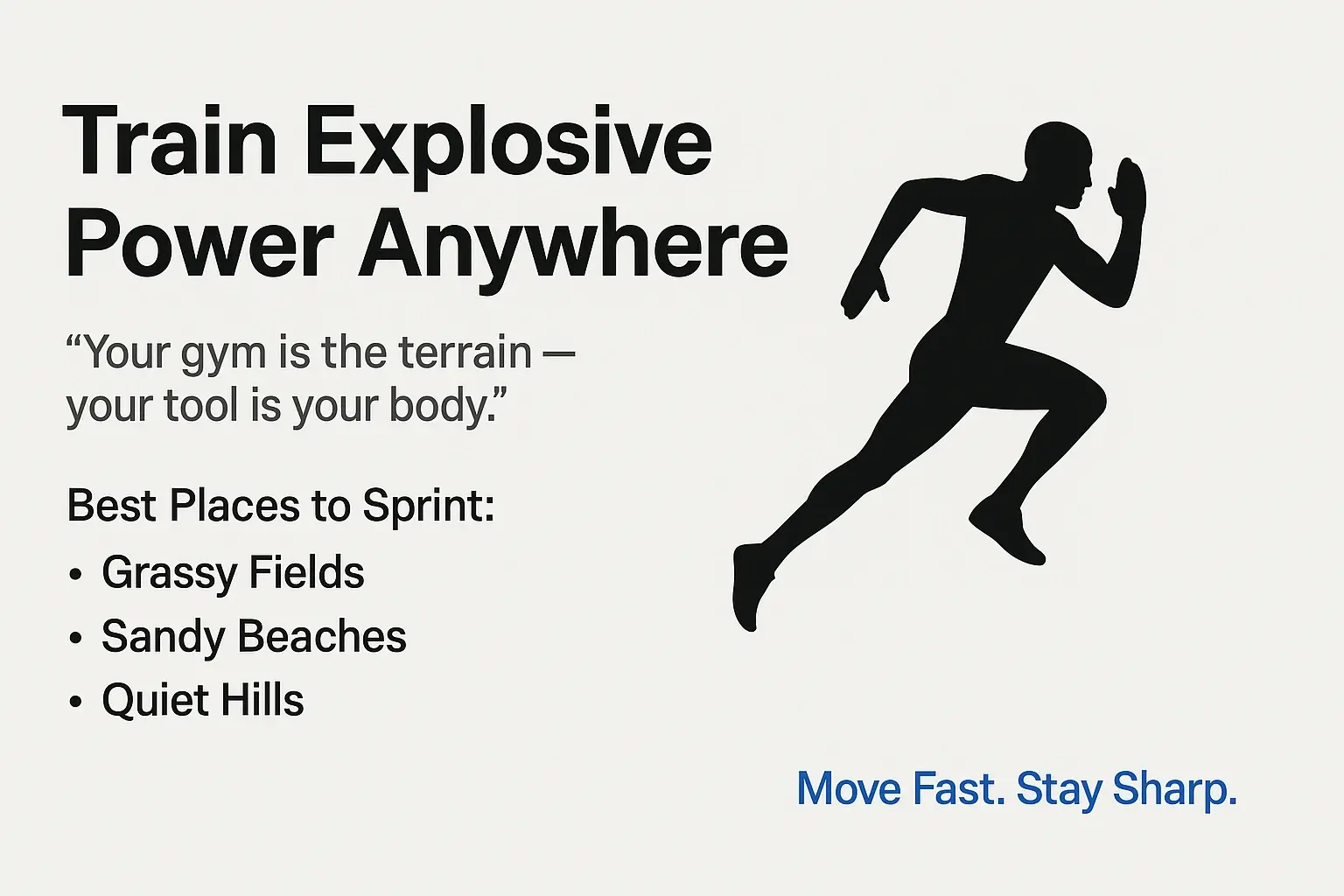
You don’t need a track or a squat rack to build explosive power. As a nomad, your gym is the terrain - your tool is your body. Sprinting and agility work builds athleticism that’s useful everywhere: in a fight, on a trail, or hauling your pack across a city in the rain.
This session is my staple. If you do nothing else this week, do this.
Best Places to Sprint & Train Explosively
“Your environment shapes your workout - choose it wisely.”
- Clear grassy fields: Soft on the joints, easy on the feet, and usually wide open. Perfect for acceleration drills and broad jumps.
- Clean sandy beaches: Adds resistance, making sprints harder and places more emphasis on the leg muscles. Early mornings are best to avoid crowds and heat.
- Quiet hills or slopes: Great for drills and acceleration work when grass and sand are out of reach.
Tip: Inspect the surface for debris and uneven spots. Minor injuries on the road costs more time and freedom than a missed session.
1. Warm-up (10–15 min)
“Move with intention, not routine.”
The warm-up is about more than heat. It’s about presence. Use this time to get mentally locked in while elevating core temperature. Don’t half-ass it. The way you jog, swing your legs, and open your hips sets the tone for the entire session.
- Jog 1–2 km at an aerobic pace (control your breathing and settle into a rhythm)
- Dynamic drills: Leg swings, torso rotations, joint rolls, patella floats
- Expand your range, not just your heart rate
Why: Most injuries come from neglecting the transition into intensity. As a nomad, you might’ve just spent 4 hours on a bus. Reset your body first.
2. Agility Activation (core technique)
“Coordination is the root of speed.”
This phase isn't glamourous - but it's where you build clean mechanics. Think of it as software tuning. Your muscles already know how to fire - these drills teach them when and how to do it efficiently.
- Marching A’s, Skipping A’s/B’s – develop rhythm
- Cross-over steps, Side skips, Jog backwards – build lateral strength + awareness
- Butt kicks, Stiff leg skips - activate the posterior chain especially hamstrings
- Run each drill 30-40 meters, 1-2 rounds each.
Why: Sprinting isn't just about force - it’s technique, posture, and fluidity. These drills program your nervous system to move with speed and control.
3. Power Primer: Broad Jumps
“Force is useless if you can’t deliver it.”
Jumping is sprinting in disguise. It's a raw expression of leg power. Treat each rep like a punch through the ground - explosive, clean, no hesitation.
- 3 sets of 5 broad jumps @ 90% intensity
- Stick the landing. Focus. Repeat.
Optional:
- Hill or stair bounds – 2×10 per leg (feel your glutes load and fire)
Why: Nomadic athletes don’t always have weights. But you’ll always have gravity. Jumping trains the same neural drive as heavy squats - without the equipment.
4. Accelerations
“Acceleration is where chaos meets control.”
These short sprints are where your power and posture merge. You 'shut it down' before reaching your top speed during these, making them less metabolically taxing. Focus on drive angles, quick steps, and gradual ramp-up. Think predator, not prey.
- 2 × 20m Accelerations @ 80–90% effort
- 2 × 40m Accelerations @ 80–90% effort
- Walk-back recoveries between efforts
Why: Max speed is built in layers. Nail your first 5–10 steps. You’re teaching your body how to explode under control - a skill that carries into combat, parkour, or any sudden movement under pressure.
5. Sprint Finishers
“Leave nothing in the tank, but never get sloppy.”
These longer sprints challenge your top-end output. It’s controlled violence - high speed, clean form, deep lungs. Don’t go 100% unless you’ve earned it through warm-up and feel locked in.
- 2–3 × 60–150m sprints @ 85–95% effort
- Full walk-back recovery after each
- Focus on posture, relaxation, and stride rhythm
Why: This is where conditioning meets speed. Not junk reps - just clean, intense efforts to stimulate adaptation without frying your CNS.
6. Cooldown & Mobility
“Power means nothing without control.”
Cooldown isn’t optional - it’s where longevity lives. As a nomad, your recovery tools are limited. That makes bodyweight holds, deep stretches, and passive hangs essential. Do this, or feel it on the next overnight bus ride.
- ATG squat hold – 1-2 min total
- Kossack squat hold - 30s each side
- Hamstring/calf stretches – 30s–1 min per side
- Dead hang / hang upside down if you have monkey bars – 2–5 min total (broken sets OK)
Why: Explosiveness requires joint mobility and tendon health. Skipping cooldown is like logging out without saving - you might lose everything you just gained.
The Nomad Advantage
Most people need a track, a coach, and an audience to train hard. You don’t. You’ve got a park, a beach, a tree branch, and a goal.
Explosive work is low-volume, high-intensity. Which makes it perfect for life on the move - minimal time, maximal return.
Stick to this once a week. Twice if your recovery’s dialed. Build everything else around it.
← Back to Main Fitness Page
Comments